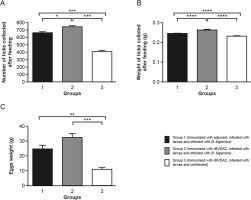Our official English website, www.x-mol.net, welcomes your
feedback! (Note: you will need to create a separate account there.)
Vaccine efficacy of recombinant BmVDAC on Rhipicephalus microplus fed on Babesia bigemina-infected and uninfected cattle.
Vaccine ( IF 4.5 ) Pub Date : 2020-01-09 , DOI: 10.1016/j.vaccine.2019.12.040 Reyna Ortega-Sánchez 1 , Minerva Camacho-Nuez 2 , Elizabeth Jacqueline Castañeda-Ortiz 2 , Máximo Berto Martínez-Benítez 2 , Diego Josimar Hernández-Silva 3 , Gabriela Aguilar-Tipacamú 4 , Juan Mosqueda 5
Vaccine ( IF 4.5 ) Pub Date : 2020-01-09 , DOI: 10.1016/j.vaccine.2019.12.040 Reyna Ortega-Sánchez 1 , Minerva Camacho-Nuez 2 , Elizabeth Jacqueline Castañeda-Ortiz 2 , Máximo Berto Martínez-Benítez 2 , Diego Josimar Hernández-Silva 3 , Gabriela Aguilar-Tipacamú 4 , Juan Mosqueda 5
Affiliation

|
Rhipicephalus microplus is the most widely distributed tick worldwide and causes significant economic losses in the livestock industry. It directly affects hosts (especially in large infestations) by feeding on blood and piercing the skin and indirectly affects hosts as a vector of pathogens that cause infectious diseases, such as bovine babesiosis. Current research on the control of ticks is focused on integrated tick control programmes, including vaccination treatment with acaricides and completely blocking pathogen transmission. Our previous studies showed that R. microplus VDAC (BmVDAC) expression is modulated by Babesia bigemina infection. VDAC is a mitochondrial protein with multiple functions in addition to its primary role as a central component of the apoptotic machinery. In this paper, we evaluated BmVDAC as an anti-tick vaccine and its capacity to block the infection of Babesia bigemina in ticks. Our results demonstrate that rBmVDAC is immunogenic and that antibodies specifically recognize the native protein from midguts of R. microplus. Immunization with rBmVDAC afforded an 82% efficacy against R. microplus infestation in the group of vaccinated cattle compared with the control group. In contrast, rBmVDAC showed a lower efficacy of 34% against tick infestation in cattle vaccinated with rBmVDAC, infested with R. microplus and infected with B. bigemina. The main effect on ticks fed in vaccinated and infected cattle was a 34% reduction in egg fertility (DF) compared to ticks fed on the control group. There was no reduction in the B. bigemina parasite levels of ticks fed on rBmVDAC-vaccinated cattle. These results suggest that the rBmVDAC protein could be tested as a vaccine for the control of tick infestation.
中文翻译:

重组BmVDAC对感染了大巴贝虫感染和未感染的牛的细小Rhipicephalus的疫苗效力。
Rhipicephalus microplus是全球分布最广泛的壁虱,在畜牧业中造成重大的经济损失。它通过摄食血液和刺穿皮肤直接影响宿主(尤其是在大批侵染中),并作为引起诸如牛巴贝病等传染病的病原体的载体间接影响宿主。当前关于tick虫控制的研究集中在综合tick虫控制方案上,包括用杀螨剂进行疫苗接种治疗并完全阻止病原体传播。我们以前的研究表明,微小芽孢杆菌VDAC(BmVDAC)表达受巴贝虫大芽孢杆菌感染的调节。VDAC是一种线粒体蛋白,除了起凋亡机制的核心作用外,还具有多种功能。在本文中,我们将BmVDAC评估为抗-虫疫苗,并评估了其在tick虫中阻止巴比斯虫(Babesia bigemina)感染的能力。我们的结果证明,rBmVDAC具有免疫原性,并且抗体可以特异性识别来自R. microplus中肠的天然蛋白质。与对照组相比,在接种牛的组中,rBmVDAC的免疫提供了对抗微小芽孢杆菌侵染的82%的功效。相比之下,在接种了rBmVDAC,感染了R. microplus并感染了双歧双歧杆菌的牛中,rBmVDAC的抗showed虱侵袭性降低了34%。与对照组相比,对接种疫苗和感染牛的tick虫的主要影响是卵育性(DF)降低了34%。用rBmVDAC疫苗接种的牛饲喂的big虫的双歧杆菌寄生虫水平没有降低。
更新日期:2020-01-11
中文翻译:

重组BmVDAC对感染了大巴贝虫感染和未感染的牛的细小Rhipicephalus的疫苗效力。
Rhipicephalus microplus是全球分布最广泛的壁虱,在畜牧业中造成重大的经济损失。它通过摄食血液和刺穿皮肤直接影响宿主(尤其是在大批侵染中),并作为引起诸如牛巴贝病等传染病的病原体的载体间接影响宿主。当前关于tick虫控制的研究集中在综合tick虫控制方案上,包括用杀螨剂进行疫苗接种治疗并完全阻止病原体传播。我们以前的研究表明,微小芽孢杆菌VDAC(BmVDAC)表达受巴贝虫大芽孢杆菌感染的调节。VDAC是一种线粒体蛋白,除了起凋亡机制的核心作用外,还具有多种功能。在本文中,我们将BmVDAC评估为抗-虫疫苗,并评估了其在tick虫中阻止巴比斯虫(Babesia bigemina)感染的能力。我们的结果证明,rBmVDAC具有免疫原性,并且抗体可以特异性识别来自R. microplus中肠的天然蛋白质。与对照组相比,在接种牛的组中,rBmVDAC的免疫提供了对抗微小芽孢杆菌侵染的82%的功效。相比之下,在接种了rBmVDAC,感染了R. microplus并感染了双歧双歧杆菌的牛中,rBmVDAC的抗showed虱侵袭性降低了34%。与对照组相比,对接种疫苗和感染牛的tick虫的主要影响是卵育性(DF)降低了34%。用rBmVDAC疫苗接种的牛饲喂的big虫的双歧杆菌寄生虫水平没有降低。









































 京公网安备 11010802027423号
京公网安备 11010802027423号